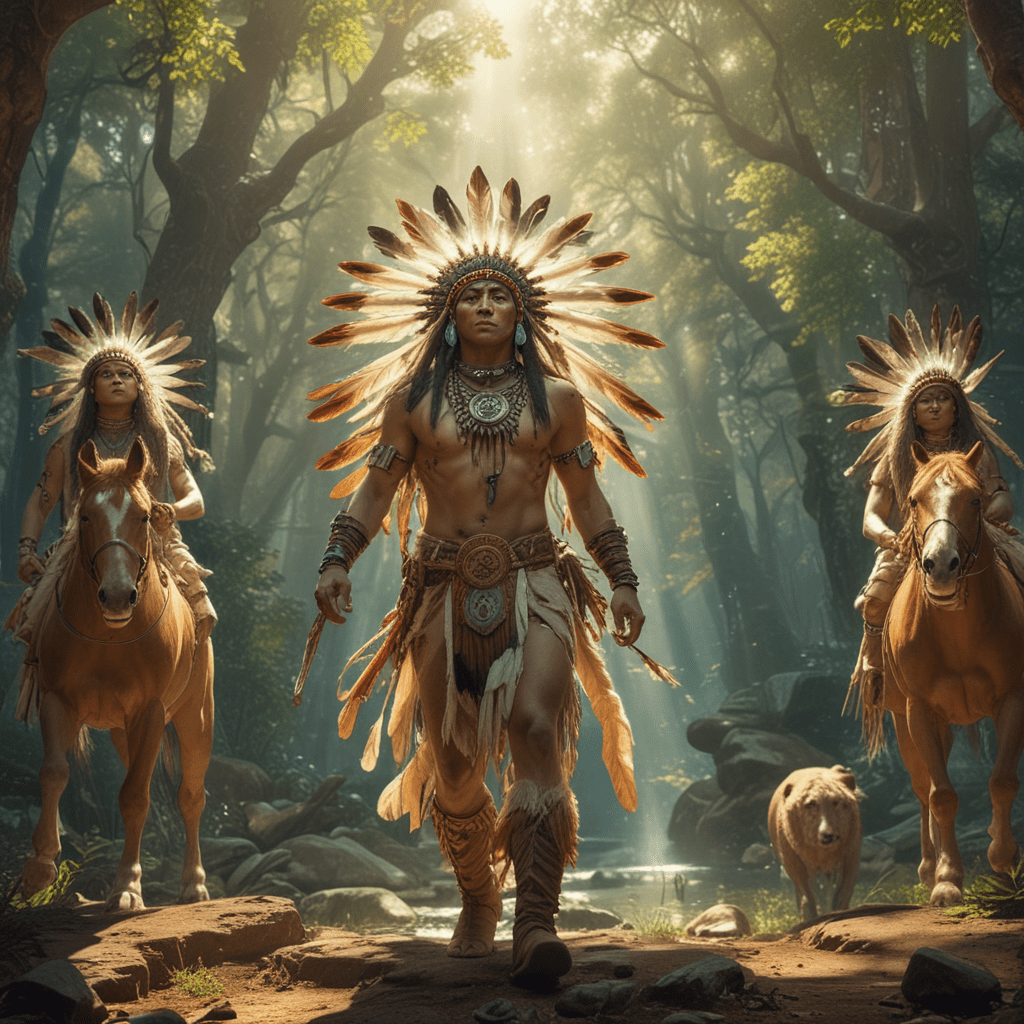Aztec Mythology: A Tapestry of Heroes and Heroines
The Aztec civilization, renowned for its advanced culture and intricate societal structure, was deeply rooted in a complex web of myths and legends. These stories, passed down through generations, played a vital role in shaping Aztec beliefs, values, and daily life. Among these captivating narratives, the tales of Aztec heroes and heroines stand out as powerful symbols of courage, wisdom, and divine intervention. These figures, often embodying the very essence of Aztec deities, served as models for individuals to emulate, inspiring them to strive for excellence and uphold the principles of their society.
The Role of Heroes and Heroines in Aztec Society
Aztec heroes and heroines were more than mere characters in stories; they were living embodiments of the values and ideals that defined Aztec society. Their actions, both heroic and tragic, served as potent lessons for the people. They taught the importance of courage in the face of adversity, the need for wisdom in decision-making, and the unwavering faith in the gods. These figures were not merely historical figures but also symbols of the divine, providing a connection between the human and the spiritual realms.
Through their actions, Aztec heroes and heroines provided examples of ideal behavior, reinforcing the social and moral order. Their bravery in battle, their dedication to their communities, and their reverence for the gods served as powerful models for aspiring warriors, rulers, and citizens alike. Their stories served as a reminder of the consequences of defying the gods or neglecting societal norms, highlighting the interconnectedness of the human and the divine in Aztec belief.
The Divine Origins of Aztec Heroes and Heroines
In Aztec mythology, the line between human and divine was often blurred. Many heroes and heroines were believed to have descended from the gods themselves, making them both divine and mortal beings. Their extraordinary abilities, often attributed to their divine lineage, allowed them to accomplish feats beyond the capabilities of ordinary mortals. This divine connection added a layer of significance to their actions, further elevating them as role models worthy of emulation.
The belief that heroes and heroines were connected to the gods strengthened their importance in Aztec society. It solidified their role as messengers and representatives of the divine realm. Their actions served as a testament to the power of the gods and the importance of maintaining a respectful and reverent relationship with them. Their stories instilled a profound sense of awe and reverence towards the deities, driving the people to seek divine favor and guidance in their endeavors.
Quetzalcoatl: The Feathered Serpent and His Role in Aztec Mythology
Quetzalcoatl, the Feathered Serpent, is one of the most prominent deities in Aztec mythology, and his story is intertwined with the origins of the Aztec people. He is often depicted as a benevolent god, associated with knowledge, art, and creation. Quetzalcoatl's mythology is filled with tales of his wisdom, his travels, and his influence on the creation of the world.
One of the most famous stories involving Quetzalcoatl is his journey to the underworld, where he battled with the god of death, Mictlantecuhtli. This tale highlights the themes of sacrifice and renewal, central to Aztec beliefs. His journey to the underworld and his eventual return symbolize the cyclical nature of life and death, a core principle in Aztec cosmology.
Huitzilopochtli: The Sun God and Warrior Patron
Huitzilopochtli, the Sun God, is a warrior deity who played a pivotal role in Aztec mythology. He is depicted as a powerful warrior, adorned with feathers and a hummingbird's headdress, representing his connection to the sun. Huitzilopochtli's mythology is closely linked to the founding of Tenochtitlan, the Aztec capital.
According to legend, Huitzilopochtli led the Aztecs on their journey from Aztlán to the Valley of Mexico. He guided them to the island of Tenochtitlan, where they ultimately founded their empire. His role in the founding of Tenochtitlan underscored his importance as a patron deity of the Aztecs, ensuring their military success and the prosperity of their civilization. Huitzilopochtli's fierce nature and his unwavering commitment to the Aztecs made him an iconic figure, inspiring warriors and rulers alike.
The Significance of Tezcatlipoca in the Aztec Pantheon
Tezcatlipoca, the "Smoking Mirror," is a complex and multifaceted deity in Aztec mythology. He is a powerful god associated with night, sorcery, and the north. Tezcatlipoca is often represented as a young man with a mirror on his chest, symbolizing his ability to see into the hearts and minds of others. He is also depicted with a foot made of obsidian, representing his role as a destructive force in the universe. His name literally means "Smoking Mirror," and this image relates to the divine power he wields – the power to see what others can’t. The Smoking Mirror reflected the unseen world, providing Tezcatlipoca with insights that were hidden to others.
Tezcatlipoca's story is a complex one, filled with both destructive and creative aspects. He is often portrayed as a trickster, a force of chaos that can both harm and help humans. He is associated with both war and magic, and is often depicted as a rival to Quetzalcoatl. One of the most famous tales of Tezcatlipoca revolves around his transformation into a beautiful woman to seduce Quetzalcoatl, leading to the god’s banishment and the loss of his divine power.
Tezcatlipoca is an important figure in Aztec mythology because he embodies the duality of life, the existence of both darkness and light. He is a reminder that the world is not always black and white, and that even the most powerful gods can be tempted and fall from grace. His role in Aztec belief underscores the importance of understanding and balancing these two opposing forces.
Xochipilli: The God of Flowers and Beauty
Xochipilli, the "Prince of Flowers," is a beloved deity in Aztec mythology, associated with beauty, joy, and pleasure. He is often depicted as a young man adorned with flowers, representing the abundance and beauty of nature. He is also associated with music and dance, and is considered the patron of artists and musicians.
Xochipilli's role in Aztec mythology is connected to the cyclical nature of life and the beauty of the natural world. He is celebrated during the festival of Toxcatl, a time for joyous celebration and the honoring of arts and beauty. This festivity coincided with the start of the dry season when flowers and plants were most abundant.
Xochipilli's story highlights the importance of beauty and joy in Aztec culture. He is a reminder that life is not just about hardship and struggle, but also about celebration and appreciation for the pleasures of life. His association with flowers and music underscores the beauty and creativity found in the natural world.
The Myth of the Five Suns: A Cosmic Origin Story
The myth of the Five Suns is a powerful creation story in Aztec mythology, explaining the origin of the world and the different ages of humanity. This story is rooted in the belief that the world has been destroyed and recreated multiple times, with each creation era associated with a specific sun.
The story explains that each sun represents a different stage in human history, and that each era was ultimately destroyed by a cataclysm. The first sun, the era of the Jaguar, was destroyed by jaguars, and the second sun, the era of the Wind, was destroyed by a powerful hurricane. The third sun, the era of the Rain, was wiped out by a deluge, and the fourth sun, the era of the Water, was consumed by fire.
According to the myth, the present age, the era of the Fifth Sun, is ruled by the god Huitzilopochtli. This era began with the sacrifice of the god Nanahuatzin, who was thrown into the fire and became the sun. The story teaches about the importance of sacrifice and the need for constant renewal and creation.
Aztec Heroes and Heroines in the Epic Poems
The stories of Aztec heroes and heroines are often found in epic poems, known as cantares, which were passed down through generations. These poems, filled with poetic language and vivid imagery, tell tales of bravery, sacrifice, and the power of the gods. They provide fascinating insights into Aztec beliefs, values, and cultural practices.
One of the most famous cantares is the Cantares Mexicanos, a collection of poems and songs that document the history and mythology of the Aztecs. These poems tell stories about great warriors like the legendary Topiltzin Quetzalcoatl, who journeyed to the underworld and returned with knowledge of the afterlife.
Another famous cantare is the Cantares de los Aztecas, which tells the story of the founding of Tenochtitlan and the rise of the Aztec empire. This poem highlights the role of Huitzilopochtli in guiding the Aztecs to their destined land and securing their destiny.
Theories on the Influence of Aztec Mythology on Modern Culture
Aztec mythology continues to be a source of inspiration for artists, writers, and filmmakers today. Modern-day stories, movies, and works of art often draw inspiration from Aztec themes and symbolism.
The influence of Aztec mythology can be seen in various forms, from popular video games to popular Hollywood films. For example, the popular video game God of War draws heavily from Aztec mythology, with references to the gods and goddesses of the Aztec pantheon.
The influence of Aztec mythology extends beyond popular culture. Many contemporary artists, particularly those working in the areas of visual art and dance, draw inspiration from the vibrant and complex world of Aztec mythology. They find inspiration in the rich iconography, the powerful stories of gods and heroes, and the intricate symbolism that is woven into the fabric of Aztec culture.
FAQ
Q: How are Aztec heroes and heroines connected to the gods?
A: Many Aztec heroes and heroines are believed to be descendants of the gods, making them both divine and mortal beings. Their extraordinary abilities often stemmed from their divine lineage, allowing them to accomplish feats that were beyond the capabilities of ordinary mortals.
Q: What are some key themes in Aztec mythology?
A: Key themes in Aztec mythology include the cyclical nature of life, the importance of sacrifice, the duality of good and evil, and the power of the gods.
Q: What is the significance of the myth of the Five Suns?
A: The myth of the Five Suns is a creation myth that explains the origin of the world and the different ages of humanity. Each sun represents a different stage in human history, and each era ultimately ends in a cataclysm. The current era, the Fifth Sun, is ruled by the god Huitzilopochtli and is marked by sacrifices and renewals.
Q: How has Aztec mythology influenced modern culture?
A: Aztec mythology has inspired artists, writers, and filmmakers, influencing popular culture through movies, video games, and art. Aztec themes and symbolism found in these works reveal the enduring legacy and relevance of Aztec mythology.



